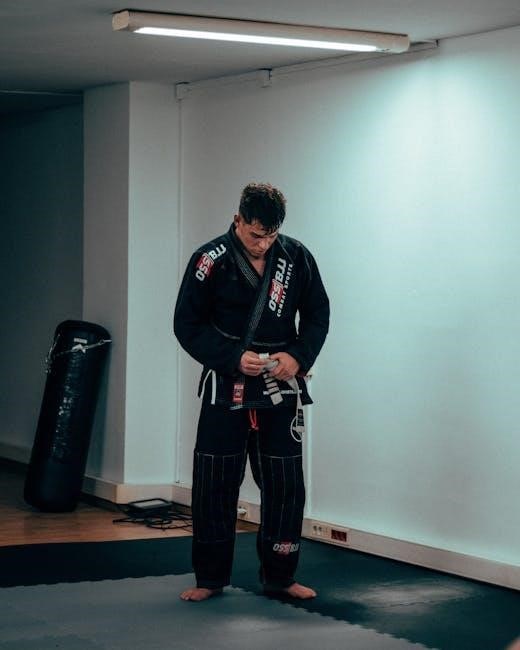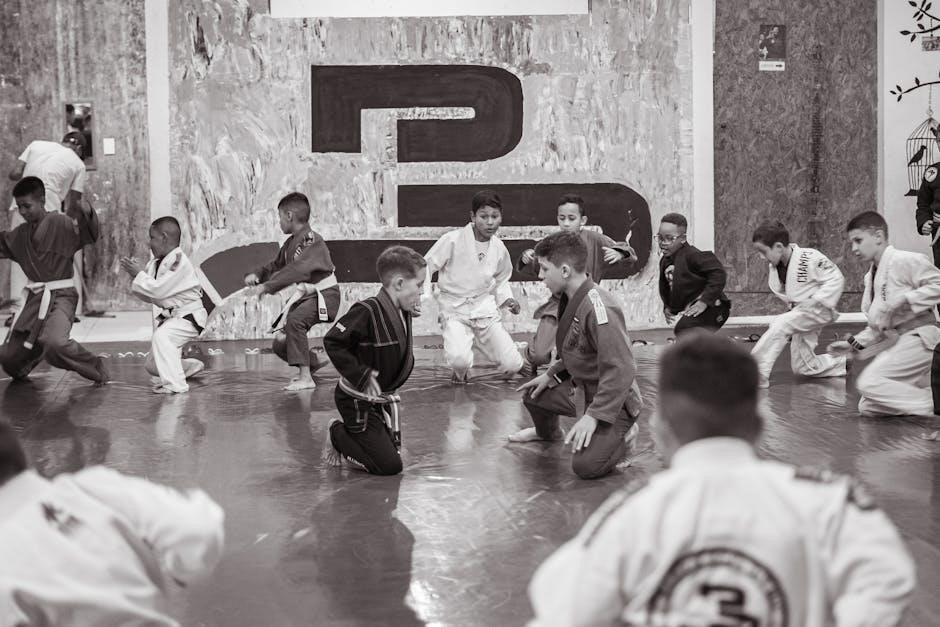Jiu Jitsu belts symbolize a practitioner’s progression in skill and knowledge. They serve as both a rank indicator and a practical tool for training. Proper sizing is essential for functionality and aesthetics, ensuring a secure grip during rolls and submissions. Understanding belt size ensures a comfortable and effective training experience.
1.1 Understanding the Importance of Belt Size in Jiu Jitsu
In Jiu Jitsu, belt size plays a critical role in both functionality and aesthetics. A properly sized belt ensures a secure grip during rolls and submissions, preventing it from coming undone mid-training. Incorrect sizing can lead to discomfort or even safety hazards, as a belt that is too loose or too tight can hinder movement or cause distractions. Additionally, official competitions, such as those governed by the IBJJF, enforce strict guidelines on belt width and length. Understanding belt size ensures compliance with these standards, promoting a professional and respectful training environment. Proper fit also enhances performance, allowing practitioners to focus on technique rather than adjusting their gear. Belt size is thus a foundational aspect of a practitioner’s journey in Jiu Jitsu.
1.2 Brief Overview of the Jiu Jitsu Ranking System
The Jiu Jitsu ranking system is a structured progression that reflects a practitioner’s technical knowledge and practical skill. It begins with the white belt for novices and advances through blue, purple, and brown belts, culminating in the esteemed black belt. Each belt represents a milestone in the journey, with upper belts (brown and black) requiring greater precision and mastery. The system emphasizes consistent training, dedication, and understanding of techniques. While belt size is crucial for functionality, the ranking system itself focuses on skill development and experience. This hierarchical structure provides clear goals and motivation for practitioners to improve, fostering growth and respect within the martial art.

Measurement Guidelines for Jiu Jitsu Belts
Accurate measurement is crucial for proper fit and functionality. Measure your natural waistline, consider your body type, and calculate belt length for optimal performance and comfort during training.
2.1 How to Properly Measure Your Waist Circumference
To measure your waist circumference accurately, wrap a flexible tape measure around your natural waistline, typically just above the hipbone. Ensure the tape is snug but not tight, keeping it parallel to the floor. This measurement is crucial for determining the ideal belt size, as it directly impacts both comfort and performance during training. Proper measurement ensures the belt stays securely in place, allowing for effective grip and technique execution. For most practitioners, the belt length is approximately twice the waist circumference, providing enough material to tie a secure double knot. Accurate measurement is the foundation for selecting the right belt size, ensuring a comfortable and functional training experience.
2.2 Determining the Ideal Belt Length for Your Body Type
The ideal belt length varies based on body type and personal preference. Generally, it should extend beyond the waist by about 12-18 inches on each side for a secure double knot. For shorter torsos, a slightly shorter belt may be more comfortable, while longer torsos may require additional length. Belt length also depends on manufacturer specifications, as some belts are designed to accommodate different body types. Proper fit ensures the belt stays in place during dynamic movements, preventing adjustments mid-training. Consulting size charts and trying belts can help determine the best fit for your frame, ensuring optimal performance and comfort on the mat.
IBJJF Belt Size Requirements

IBJJF specifies belts must be 4-5 cm wide, with ends hanging 20-30 cm after a double knot. Proper sizing ensures compliance with tournament regulations and optimal performance.
3;1 Official Guidelines for Belt Width and Length
The IBJJF mandates that Jiu Jitsu belts must be between 4 to 5 centimeters in width, ensuring uniformity across all competitors. The length of the belt is equally important, as it must be long enough to wrap around the waist comfortably and tie a proper double knot. Once tied, each end of the belt should extend 20 to 30 centimeters beyond the knot, allowing for a secure and neat appearance. These specific measurements ensure that the belt remains functional during rolls and submissions, while also meeting the aesthetic standards expected in competitions and training environments. Proper adherence to these guidelines is crucial for both performance and compliance with official regulations.

3.2 How Belt Size Varies by Manufacturer
While the IBJJF sets standard guidelines, belt sizes can vary slightly between manufacturers. Some brands offer sizing options like A1, A2, A3, and A4, catering to different body types. For example, A2 is often recommended for individuals with an average build, while A3 or A4 may suit taller or broader practitioners. Manufacturers also differ in belt length and width tolerances, though they must remain within IBJJF limits. It’s essential for practitioners to measure their waist and compare sizes across brands to find the best fit. Some brands offer longer belts for taller individuals, while others specialize in shorter lengths for smaller frames. Always check the manufacturer’s size chart to ensure compliance with official standards and personal comfort during training.
Choosing the Right Belt Size for Your Skill Level
Belt size isn’t tied to skill level but ensures comfort and functionality. White belts focus on proper fit, while upper belts may prioritize durability for intense training.
4.1 Belt Size Considerations for Beginners (White Belt)
As a white belt, choosing the right belt size focuses on comfort and functionality. Proper fit ensures ease of movement during training. Measure your waist accurately to determine the ideal length. The belt should sit snugly, allowing for a full range of motion without being too tight. For beginners, a belt that is neither too loose nor too tight is essential for learning techniques effectively. While size doesn’t indicate skill level, a well-fitted belt supports training performance. Prioritize durability and a smooth texture to prevent chafing. By selecting the right size, you ensure a comfortable and effective start to your Jiu Jitsu journey.
4.2 Belt Size Considerations for Advanced Practitioners (Upper Belts)
For upper belts, such as brown and black, belt size becomes more critical due to increased technical demands. The belt must provide a secure grip, allowing precise control during advanced techniques. Proper length ensures the belt stays tied securely, preventing interruptions during training. Advanced practitioners often prefer a slightly shorter belt for better stability, while maintaining enough length for a double knot. The width should align with IBJJF standards, typically 4-5 cm, to ensure consistency and professionalism. Selecting a high-quality belt that offers durability and a firm grip is essential for upper belts, as it supports their refined skills and expertise in Jiu Jitsu.

Common Mistakes to Avoid When Selecting a Belt
Common errors include ignoring proper measurements, choosing belts too tight or loose, and not considering manufacturer size variations. These mistakes can hinder performance and comfort.
5.1 Overlooking the Importance of Belt Length
Ignoring belt length is a common mistake that can lead to discomfort and poor performance. A belt that’s too short may not stay tied, while one that’s too long can cause distractions during training. Proper length ensures the belt can be securely knotted without excess material flapping, which is especially important during rolls and submissions. Many practitioners focus solely on waist size but neglect to measure for appropriate length, leading to ill-fitting belts. Ensuring the belt ends are long enough to tie a double knot comfortably is crucial for both functionality and adherence to IBJJF guidelines; This oversight can disrupt training and overall performance.
5.2 Choosing a Belt That Is Too Tight or Too Loose
Selecting a belt that is either too tight or too loose can hinder training effectiveness and comfort. A tight belt restricts movement and breathing, potentially causing discomfort during rolls and submissions. Conversely, a loose belt may repeatedly come undone, disrupting training flow and requiring constant adjustments. Proper fit ensures the belt stays securely tied without restricting mobility. Many practitioners underestimate the impact of belt tightness on performance, leading to unnecessary distractions. Ensuring the belt is snug but not overly tight is crucial for optimal training. Ignoring this balance can result in a less efficient and enjoyable practice, emphasizing the importance of careful size selection. Always aim for a belt that provides both security and freedom of movement.
Proper belt sizing is vital for both functionality and aesthetics in Jiu Jitsu. Ensuring a secure, comfortable fit enhances performance and training comfort, fostering progress in your journey.
6.1 Final Tips for Ensuring the Perfect Fit
To achieve the perfect Jiu Jitsu belt fit, measure your waist accurately and consider your body type. Ensure the belt is snug but not restrictive, allowing for a full range of motion. Opt for a length that allows the ends to hang evenly when tied in a double knot. Try the belt on before purchasing if possible, and check the manufacturer’s sizing chart. Remember, a proper fit enhances performance and comfort during training. Regularly wash and maintain your belt to prevent shrinkage and ensure longevity. By following these tips, you’ll secure a belt that supports your Jiu Jitsu journey effectively.
6.2 The Role of Belt Size in Your Jiu Jitsu Journey
Belt size plays a pivotal role in your Jiu Jitsu journey, serving as both a functional tool and a symbol of progress. A well-fitted belt ensures optimal performance, providing a secure grip during techniques and submissions. It also represents your commitment and growth, as each size corresponds to a skill level. Proper sizing fosters confidence and focus, allowing you to concentrate on mastering techniques rather than adjusting your gear. Over time, your belt becomes a testament to your dedication, enduring through countless training sessions. By prioritizing the right fit, you honor the tradition of Jiu Jitsu while enhancing your training experience. Remember, your belt is not just an accessory—it’s a companion in your martial arts journey.
